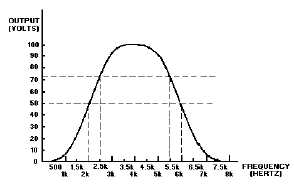5
Figure 1A.—Frequency-response curve.
IN ANSWERING QUESTIONS 1-35 AND
1-36 REFER TO FIGURE 1A.
1-35. What are the (a) upper and (b) lower
frequency limits shown?
1. (a) 8 kHz
(b) 0 Hz
2. (a) 7.5 kHz
(b) 0 Hz
3. (a) 6.0 kHz
(b) 2 kHz
4. (a) 5.5 kHz
(b) 2.5 kHz
1-36. What is the bandwidth shown?
1. 1 inch
2. 8 kHz
3. 3 kHz
4. 2 kHz to 8 kHz
1-37. Which of the following limit(s) the
frequency response of a transistor
amplifier?
1. The inductance
2. The transistor
3. The capacitance
4. All of the above
1-38. What type of feedback is caused by
interelectrode capacitance?
1. Bypassed
2. Negative
3. Positive
4. Regenerative
1-39. What happens to capacitive reactance as
frequency decreases?
1. It increases
2. It decreases
3. It remains the same
4. It cannot be determined
1-40. What happens to inductive reactance as
frequency increases?
1. It increases
2. It decreases
3. It remains the same
4. It cannot be determined
1-41. What is the major factor that limits the
high frequency response of an amplifier?
1. Inductance
2. Resistance
3. Capacitance
4. Transformer reactance
1-42. What components can be used to
increase the high-frequency response of
an amplifier?
1. Diodes
2. Inductors
3. Resistors
4. Capacitors
1-43. What determines whether a peaking
component is considered "series" or
"shunt"?
1. The relationship of the component to
the power supply
2. The relationship of the component to
the input signal path
3. The relationship of the component to
the amplifying device
4. The relationship of the component to
the output signal path

